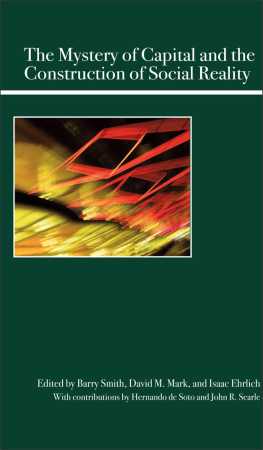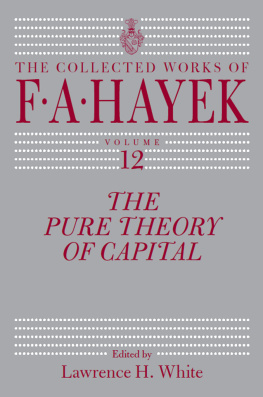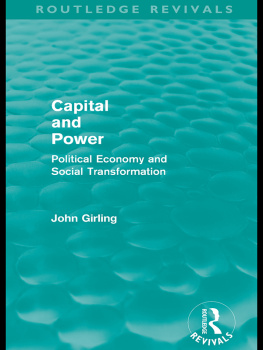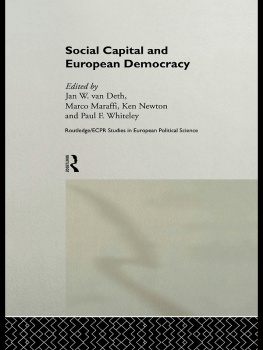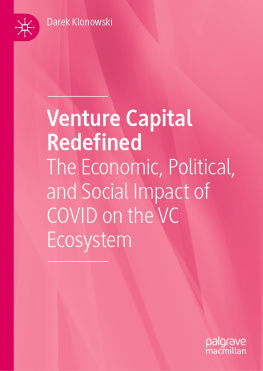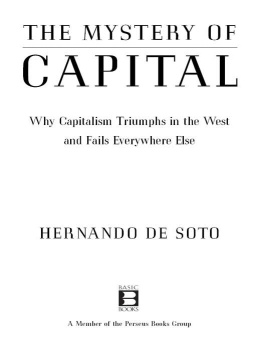
To order books from Open Court, call toll-free 1-800-815-2280, or visit our website at www.opencourtbooks.com.
Open Court Publishing Company is a division of Carus Publishing Company.
Copyright 2008 by Carus Publishing Company
First printing 2008
All rights reserved. No part of this publication may be reproduced, stored in a retrieval system, or transmitted, in any form or by any means, electronic, mechanical, photocopying, recording, or otherwise, without the prior written permission of the publisher, Open Court Publishing Company, a division of Carus Publishing Company, 315 Fifth Street, P.O. Box 300, Peru, Illinois 61354-0300.
Library of Congress Cataloging-in-Publication Data
The mystery of capital and the construction of social reality / edited by Barry
Smith, David M. Mark, Isaac Ehrlich.
p. cm.
Summary: A collection of essays by philosophers and social scientists addressing Hernando de SotosThe Mystery of Capitaland John R. SearlesThe Construction of Social Reality Provided by publisher.
Includes bibliographical references and index.
ISBN 978-0-8126-9933-3 1. Social sciencesPhilosophy. 2. Capital. I. Smith, Barry. II. Mark, David M. III. Ehrlich, Isaac.
H61.15.M97 2008
300.1dc22
2008009330
Contents
I n his book The Construction of Social Reality, John Searle has advanced a new way of understanding human society and its institutions: What holds a human society together? What factors lead to the collapse of a society? What are the roles of power, belief, and trust in sustaining social institutions?
Hernando de Sotos bestselling book The Mystery of Capital has contributed to refocusing the attention of development economists and policy makers on the role of property rights in economic development. The somewhat provocative subtitle of de Sotos book is: Why Capitalism Triumphs in the West and Fails Everywhere Else. His thesis is simple. The poor in developing countries often have many assetshomes, informal businesses, plots of land. What they lack is formal property rights to these assets. This deficiency diminishes their potential worth as financial assets (for example, by blocking their use as collateral for borrowing) or even as real assets (for example, by preventing utilities such as gas and electricity from being legally connected to them).
Another asset that the poor in developing countries almost universally lack is human capital including, but not limited to, formal schooling and continuing technological advance. Any solution to the mystery of capital thus must address how this intangible, but critical, human asset is produced and accumulated.
The main goal of this book is to discuss the ideas on social ontology proposed by Searle and de Soto, and to further explore the implications of their views, and those of other contributors to this volume, for the understanding of economic growth and development, and the philosophy of social institutions. While de Sotos Mystery of Capital was in part influenced by Searles ideas on social ontology, and while a number of important interconnections between Searles and de Sotos work can be seen, these interconnections have not hitherto been subjected to analysis. Contributions to this book also expand de Sotos approach to capitalization of tangible assets to include the capitalization of intangible assets such as information and knowledge, or human capital, which are identified as the long-term engine of growth in the fast-growing endogenous-growth-and-development literature in economics.
The prime focus of the volume is: how can philosophers learn from economists, and how can economists learn from philosophers, in understanding what works and what does not work in human societies? De Soto and Searle have themselves provided chapters presenting definitive accounts of their recent thinking on these topics. In the remaining chapters, experts on ontology, information science, land registration, geography, and endogenous growth and development present their views, commenting primarily on the work of de Soto and Searle but also offering their own original contributions to the new social ontology and endogenous economic growth paradigm, which are currently being established.
A Huge Invisible Ontology
Searle begins The Construction of Social Reality with the following simple scene: I go into a caf in Paris and sit in a chair at a table. The waiter comes and I utter a fragment of a French sentence. I say, un demi, Munich, pression, sil vous plat. The waiter brings the beer and I drink it. I leave some money on the table and leave (Searle 1995, 3). He then points out that the scene described is more complex than at first appears: the waiter did not actually own the beer he gave me, but he is employed by the restaurant which owned it. The restaurant is required to post a list of the prices of all the boissons, and even if I never see such a list, I am required to pay only the listed price. The owner of the restaurant is licensed by the French government to operate it. As such, he is subject to a thousand rules and regulations I know nothing about. I am entitled to be there in the first place only because I am a citizen of the United States, the bearer of a valid passport, and I have entered France legally (1995, 3). The task Searle then sets for himself is to describe this huge invisible ontology, which is to say, to give an analysis of those special powers, functions, acts, events, states, properties, and relationspicked out in italics in the abovewhich do not belong to the realm of brute physical reality but rather to the realm of institutions. Searles idea, very roughly, is that by acting collectively in accordance with rules of a special kindwhich he calls constitutive ruleswe are able to impose rights, duties, obligations, and various other sorts of what he calls status functions and deontic powers on our fellow human beings and on the reality around us.
Status functions are functionssuch as those of customs officials (with their rubber stamps)which the human beings involved could not perform exclusively in virtue of their physical properties. Consider the way in which a line of yellow paint can perform the function of a barrier because it has been collectively assigned the status of a boundary marker by human beings. The yellow paint is unable to perform this function by virtue of its physical properties. It performs the function only because we collectively accept it as having a certain status. Money, too, does not perform its function by virtue of the physical properties of paper, ink, or metal, but rather in virtue of the fact that we, collectively, grant the latter a certain status and therewith also certain functions and powers.
Powers can be positive, as when John is awarded a license to practice medicine, or negative, as when Mary has her license to drive taken away for speeding or when Sally is obliged to pay her taxes. Powers can be substantive, as when Margaret is elected Prime Minister, or attenuated, as when Elton is granted the honorary title of Knight Bachelor, Commander of the British Empire. Chess is war in attenuated form, and it seems that very many of the accoutrements of culture have the character of attenuated powers along the lines described by Searle.
Searles theory of collective intentionality, of status functions, and of deontic powers is a brilliant contribution to the ontology of social reality. As he puts it: [There is a] continuous line that goes from molecules and mountains to screwdrivers, levers, and beautiful sunsets, and then to legislatures, money, and nation-states. The central span on the bridge from physics to society is collective intentionality, and the decisive movement on that bridge in the creation of social reality is the collective intentional imposition of function on entities that cannot perform these functions without that imposition (Searle 1995, 41). Searles account of the way in which so much of what we value in civilization requires the creation and the constant monitoring and adjusting of the institutional power relations which arise through collectively imposed status functions is certainly the most impressive theory of the ontology of social reality we currently have. His account of how the higher levels of institutional reality are created via iteration of the imposition of status functions, and also of how whole systems of such iterated structures (for example the systems of
Next page
